I am sorry but I can't quite figure out how to properly search for this. What I am wondering is if there is software (freeware... hope hope) that will identify a point on a screen image.
What I want to do is accurately mine the X-Y values on a displayed set of plate curves. The idea is to display the curves on the screen and use the mouse to define the X an Y range, select linear or log for each axis and then be able to click on any point in the image and get the X and Y values according to the scale thus defined.
The application is the analysis of plate curves from published data.
Does such a thing exist?
mike
What I want to do is accurately mine the X-Y values on a displayed set of plate curves. The idea is to display the curves on the screen and use the mouse to define the X an Y range, select linear or log for each axis and then be able to click on any point in the image and get the X and Y values according to the scale thus defined.
The application is the analysis of plate curves from published data.
Does such a thing exist?
mike
In Visual Basic (student version available free or cheap) the screen can be addressed in X-Y pixels I think. I haven't used this feature, I just read about it in the graphics tutorial. Should be some way to import the image then scan by pixel.
Might want to take a look a Yvesm's curve tracer software too. Source code downloadable there. Maybe some other software around too. Like the MCU tracer maybe?
http://www.dissident-audio.com/Traceur/Page.html
Don
Might want to take a look a Yvesm's curve tracer software too. Source code downloadable there. Maybe some other software around too. Like the MCU tracer maybe?
http://www.dissident-audio.com/Traceur/Page.html
Don
curvecaptor
Mike :
What you want is CurveCaptor. It does exactly what you describe : it loads a gif file image, puts X and Y scales ( voltage and current ) on, and then click on points and record the data. It then will produce a triode spice model, which may or may not be what you want, but that is up to you, the point is you can save the data and do what ever you want with it. Doesnt have to be for tubes. I use it for the triodes as mentioned, and also for collecting pentode data, which I then analyse myself.
To find it, do a search in this forum.
Does such a thing exist?
Mike :
What you want is CurveCaptor. It does exactly what you describe : it loads a gif file image, puts X and Y scales ( voltage and current ) on, and then click on points and record the data. It then will produce a triode spice model, which may or may not be what you want, but that is up to you, the point is you can save the data and do what ever you want with it. Doesnt have to be for tubes. I use it for the triodes as mentioned, and also for collecting pentode data, which I then analyse myself.
To find it, do a search in this forum.
mashaffer said:I am sorry but I can't quite figure out how to properly search for this. What I am wondering is if there is software (freeware... hope hope) that will identify a point on a screen image.
What I want to do is accurately mine the X-Y values on a displayed set of plate curves. The idea is to display the curves on the screen and use the mouse to define the X an Y range, select linear or log for each axis and then be able to click on any point in the image and get the X and Y values according to the scale thus defined.
The application is the analysis of plate curves from published data.
Does such a thing exist?
mike
This is laborious but will work -- use CTRL-PRT_SCRN then past the image to MSPaint. Cut the image to only that portion you need. Move the cursor to the point which you want to record as "0,0" and record the X,Y values -- they are in box inthe lower right hand of the screen. Each succesive time you move the cursor record the X,Y values -- when you subtract out the origin it will give you the appropriate absolute X and Y values.
There are many programs which will convert vector or raster-graphics to numeric values, but you shouldn't have to pay $700 or more to do this if you only need it sparingly.
Norm Koren explains deriving tube curves with MathCAD or MatLAB -- it's a bit **** backwards from the "hypothesis-conclusion" we learned as undergrads -- that's why it was important to stay awake in all those calculus classes.
Since I posted I found this and downloaded it. It looks like it will really do the trick. I used the following procedure.
1. Window capture of curves from a Mullard data sheet (pdf) using GIMP. I cropped and saved the resulting file.
2. Open GIMP output file in windows paint and used line drawing function to put in a proposed load line.
3. Import the resulting drawing into Engauge.
4. Set the axis points.
5. Point to the data points of interest and enter the needed values in a spreadsheet using Steve Bench's formulas for Power, HD2,3,and4
It seemed to work quite well. Doing the same thing for PP may be a bit trickier but will be fun to try.
Here is the image that I imported into Engauge.
mike
1. Window capture of curves from a Mullard data sheet (pdf) using GIMP. I cropped and saved the resulting file.
2. Open GIMP output file in windows paint and used line drawing function to put in a proposed load line.
3. Import the resulting drawing into Engauge.
4. Set the axis points.
5. Point to the data points of interest and enter the needed values in a spreadsheet using Steve Bench's formulas for Power, HD2,3,and4
It seemed to work quite well. Doing the same thing for PP may be a bit trickier but will be fun to try.
Here is the image that I imported into Engauge.
mike
Attachments
- Status
- Not open for further replies.
- Home
- Amplifiers
- Tubes / Valves
- Data point software?

